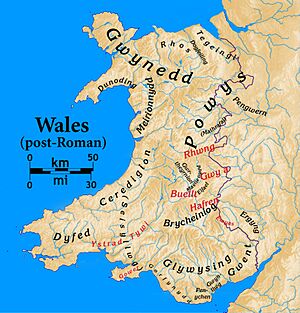Pengwern facts for kids
Pengwern was an ancient settlement in Britain. It was home to the Brythonic people. This was during a time called sub-Roman Britain, after the Romans left. Today, this area is in Shropshire, England. It is very close to the border with Wales. Many historians think Pengwern was an early capital for the kings of Powys. Powys was a powerful Welsh kingdom. Later, its capital moved to Mathrafal, further west. Some also think Pengwern might have been its own small kingdom. The exact spot where Pengwern was located is still a mystery.
The Story of Pengwern
Nobody knows exactly when Pengwern was founded. But Welsh stories say it was part of the Welsh kingdom of Powys. This was during the early Middle Ages. The old kingdom of Powys was much bigger than the later one. It covered the land of the Celtic Cornovii tribe. Their main city under Roman rule was Viroconium Cornoviorum (now Wroxeter).
After the Roman legions left, Viroconium Cornoviorum took control. But some areas around it might have rebelled. They may have started a new power center, which became Powys. Between 530 and 550 AD, Viroconium Cornoviorum was abandoned. This was like many other Roman towns in Britain. It might have later become part of the royal court of Llys Pengwern.
Stories about Cynddylan, a king of Pengwern, were written down around the 9th century. These are found in poems called Canu Heledd. This collection is named after Cynddylan's sister. These poems say that Cynddylan's home was at Pengwern. These stories are part of a larger group of poems. They tell about heroes and sad events in early Powys.
Where Was Pengwern?
Several places in Shropshire are mentioned in the old poems. But the exact location of Llys Pengwern (the Court of Pengwern) is not known. This is tricky because other places in Wales are also called Pengwern. For example, there's one near Denbigh in North Wales.
A story from the late 12th century links Pengwern to modern Shrewsbury. However, Shrewsbury has been known as Amwythig in Welsh for a long time. Many other places have been suggested as the true site of Pengwern.
- One idea is the Berth, a large hillfort near Baschurch. But archaeologists have only found an Iron Age fort there. There might have been some Roman use too.
- Wroxeter, the old Roman town of Viroconium Cornoviorum, is also nearby. People lived in Wroxeter even after the Romans left. But it was finally abandoned around 520 AD. This was when the Roman-British government broke down.
- A fort on the Wrekin, a hill near Wroxeter, has also been suggested.
- Another idea is that the old earthworks under Whittington Castle might be Pengwern.
War with Northumbria
King Cynddylan of Pengwern joined forces with King Penda of Mercia. They wanted to protect their lands. This might also have been for personal reasons. Cynddylan's brother, Gwion, had been killed in the Battle of Chester.
Together, Cynddylan and Penda fought against Northumbria. Northumbria was a powerful kingdom of the Angles. They fought at the Battle of Maes Cogwy (now Oswestry) in 642 AD. Their enemy, King Oswald, was killed there. This battle brought peace for a while.
But after Penda died, Northumbria attacked again. King Oswiu of Northumbria, Oswald's brother, led a surprise raid. He attacked northern Mercia. Later, he attacked Cynddylan's palace at Llys Pengwern. The attack was a complete surprise. The royal family, including the king, were killed. The palace was burned to the ground. Princess Heledd was the only one who survived. She fled to western Powys.
After this tragedy, the land around Pengwern was split. It was shared between Mercia and Powys. Part of it stayed Welsh until the time of Offa of Mercia. He built Offa's Dyke, a large earth barrier. Part of the land became the Anglian sub-kingdom of the Magonsæte.
Pengwern Today
The name Pengwern is still used today. In Shrewsbury, there is the Pengwern Boat Club. It is on the banks of the River Severn. It is across from The Quarry park. Other shops and businesses in the area also use the name Pengwern.


